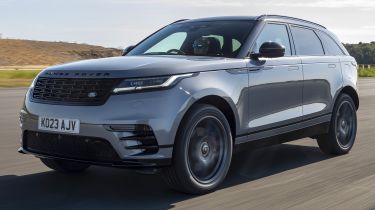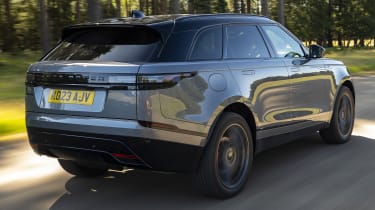Range Rover Velar review
Offering plenty of kerb appeal, the stylish Range Rover Velar is a desirable alternative to its premium mid-size SUV rivals

The Range Rover Velar is a supremely stylish SUV that offers the level of comfort and refinement you’d expect from any car that bears the Range Rover name. There’s a good selection of engines, including a plug-in hybrid that’ll appeal to company car drivers, and for a car of this size, the Velar is surprisingly decent to drive.
However, the Velar’s interior is something of a mixed bag. It’s spacious, well finished and features JLR’s excellent Pivi Pro infotainment system from its flagship Range Rover and Range Rover Sport models. But the updated SUV heavily prioritises form over function, ditching physical controls for the sake of an uber-minimalist look, and can only carry four people comfortably.
About the Range Rover Velar
The rakishly elegant Range Rover Velar is JLR’s entry into the premium mid-size SUV segment, and so must do battle with a variety of highly-rated competitors including our current favourite in this class – the Lexus NX – as well as the Audi Q5, BMW X3 and all-electric iX3, Mercedes GLC, Porsche Macan, Volvo XC60 and Jaguar’s own F-Pace.
But the Velar’s tapered roofline and elegant rear quarters are clearly not designed for maximum practicality like its boxier rivals. It’s also the closest model in the Range Rover lineup to a coupe-SUV, meaning it must contend with the likes of the Audi Q5 Sportback, BMW X4 and Mercedes GLC Coupe, too.
The Velar’s interior is spacious, lavishly equipped, comfortable and features the latest technology JLR has to offer, although you’ll immediately notice the highly minimalist approach to its cabin design that could almost be described as Tesla-like. The only controls found on the new centre console are the gear selector and hazard-warning switch, with everything else moved to the central touchscreen.
Used - available now

2021 Land Rover
Range Rover Velar
18,555 milesAutomaticPetrol2.0L
Cash £31,000
2023 Land Rover
Range Rover Velar
33,346 milesAutomaticDiesel3.0L
Cash £34,700
2023 Land Rover
Range Rover Velar
46,139 milesAutomaticDiesel2.0L
Cash £33,100
2020 Land Rover
Range Rover Velar
18,512 milesAutomaticPetrol2.0L
Cash £30,000Every model features an automatic gearbox and four-wheel drive, but there is a wide range of different engines available, including petrol, diesel and plug-in hybrid powerplants. Diesel options include the entry-level D200 four-cylinder with 201bhp, followed by a 3.0-litre six-cylinder producing 296bhp, badged D300.
Petrol options kick off with a 247bhp 2.0-litre four-cylinder badged as the P250, while the more powerful P400 pumps out 394bhp from its 3.0-litre six-cylinder. The P250 is the only one of the four engines that doesn’t feature mild-hybrid technology.
If you want a stepping stone to living with an electric car, or are on the hunt for a stylish SUV for your next company car, then the plug-in hybrid P400e combines a 2.0-litre petrol engine and electric motor for a 398bhp total power output, plus a pure-electric driving range of up to 40 miles. There’s no EV version of the Velar unfortunately, but we have learned that the next-generation model will be all-electric.
If you're looking for a 296bhp P300 model, or the 542bhp SVAutobiography Dynamic Edition (badged P550), then it'll have to be a used example, as both have been removed from the Velar price list.
There are currently four trim levels to choose from: S, Dynamic SE, Dynamic HSE and Autobiography. Every Velar is equipped with alloy wheels (starting at 19 inches), a fixed panoramic roof, LED headlights, leather upholstery, heated front seats, a 12.3-inch digital driver’s display, 11.4-inch Pivi Pro touchscreen, wireless Apple CarPlay and Android Auto connectivity, a rear-view camera and several driver-assistance systems. Pricier models add larger wheels (20 to 22 inches), more aggressive styling, upgraded leather upholstery, a Meridian sound system and Pixel LED lights.
Prices start from around £54,000, and just In case you’re wondering about the Velar name, it goes all the way back to the 1960s when it was used as an alias to disguise original Range Rover prototypes. It’s derived from the Italian verb ‘velare’ meaning ‘to veil or cover’.










